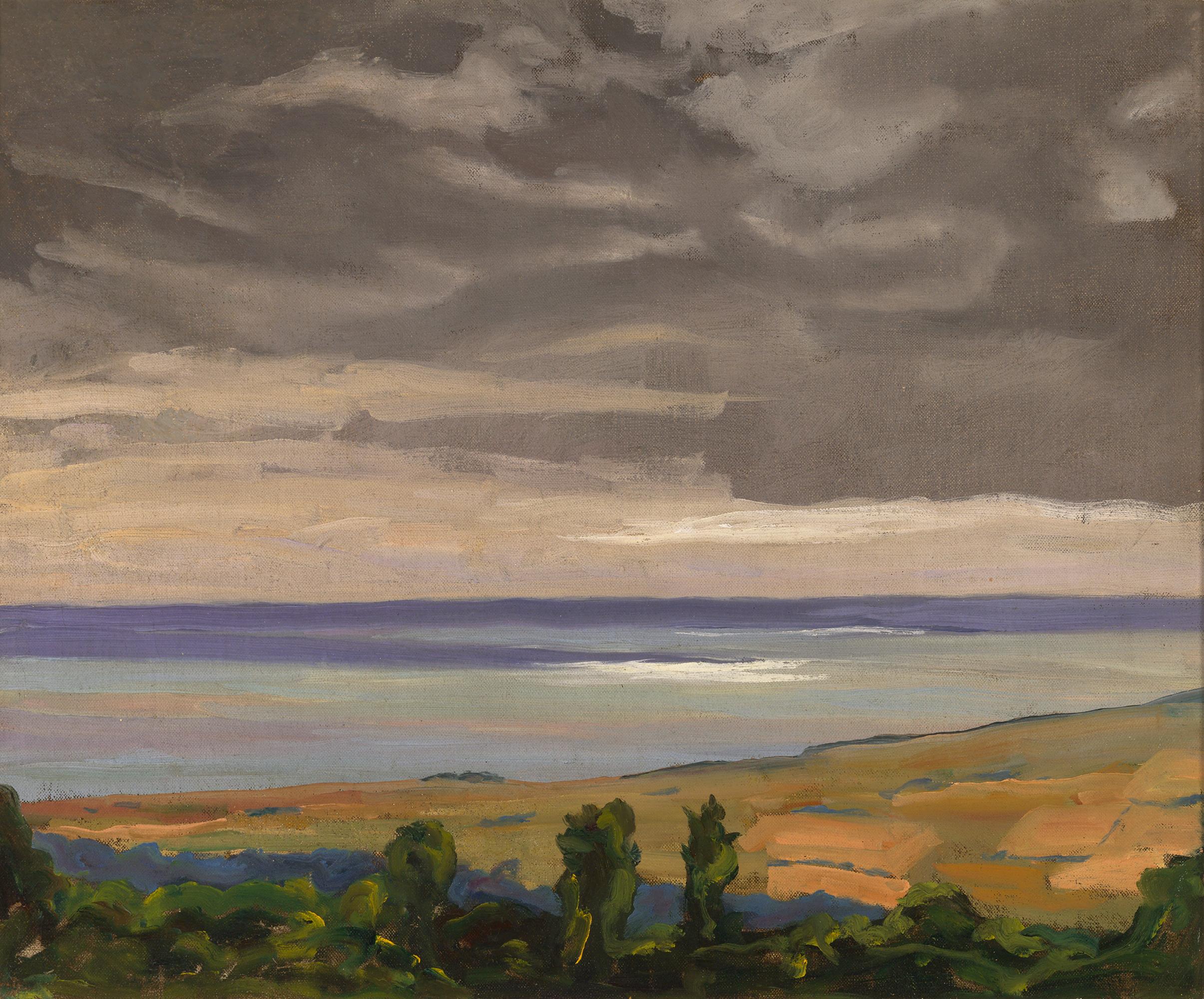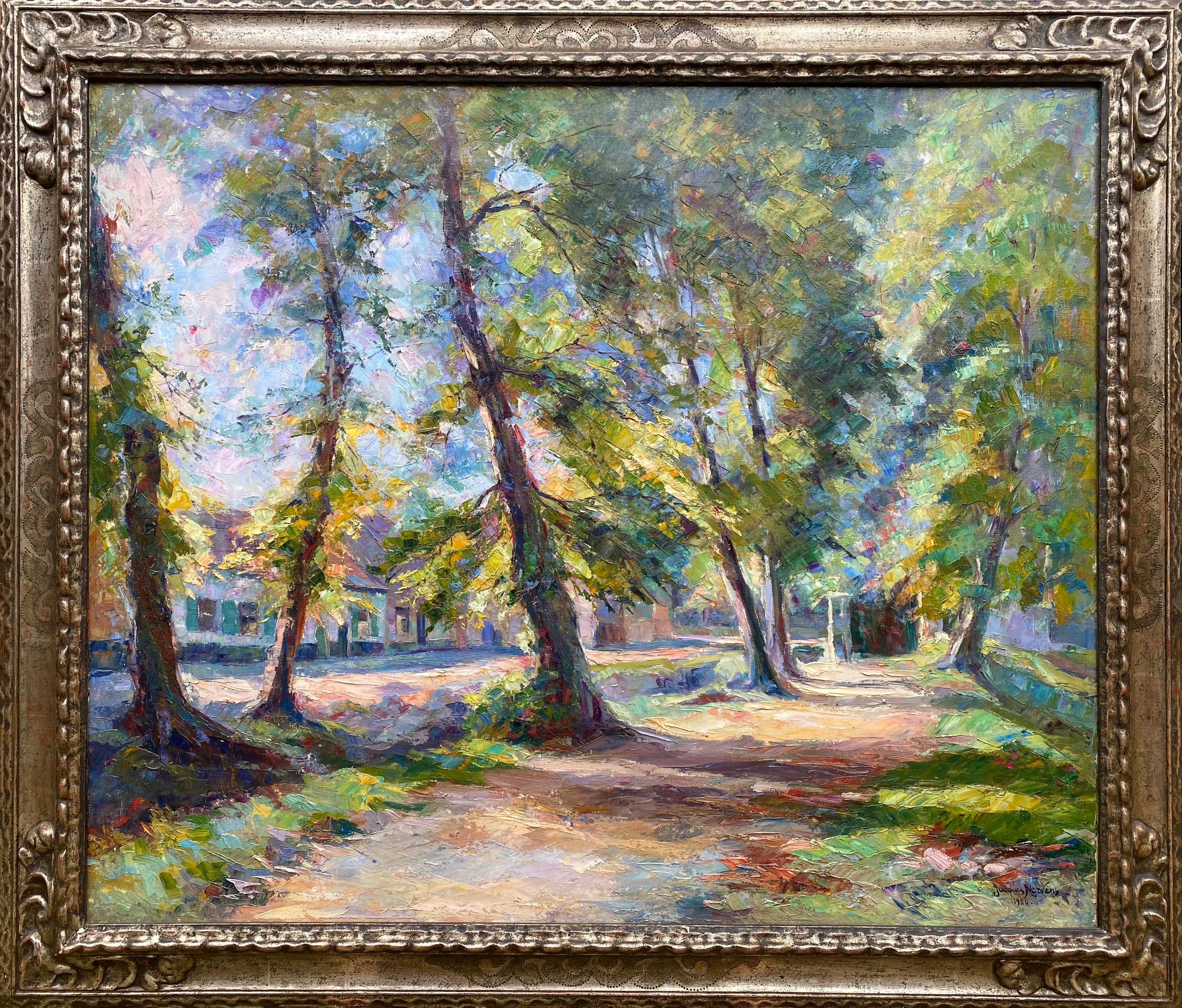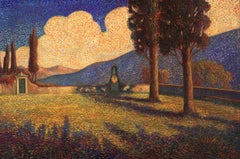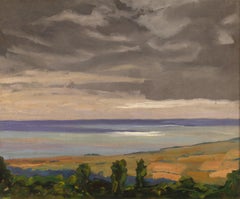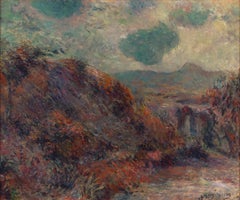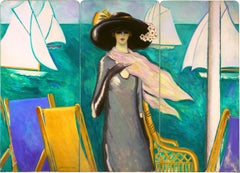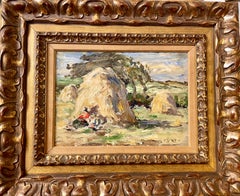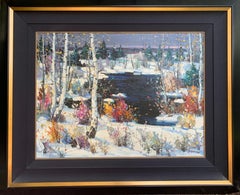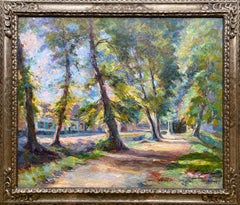Items Similar to The Garden Near Cailhau By Achille Laugé
Want more images or videos?
Request additional images or videos from the seller
1 of 10
Achille LaugéThe Garden Near Cailhau By Achille LaugéCirca 1896
Circa 1896
About the Item
Achille Laugé
1861-1944 French
The Garden Near Cailhau
Signed "A. Laugé 96" (lower left)
Oil on canvas
“Laugé’s art is one of great sensitivity and controlled reason; he is a master of light.” — Antoine Bourdelle, French Artist, Esteemed Peer, June 1927
This incredible work by Achille Laugé entitled The Garden Near Cailhau showcases the masterful artist at his very best. During his lifetime, Achille Laugé was celebrated by his peers and the public alike for producing dazzling works with subtly divided southern light, pure tones and rigorous geometry. His reputation continued to grow after his death, and today the art market recognizes him as a master of Neo-Impressionism. Though his command of the pointillist and divisionist styles often draws comparison to his Neo-Impressionist peers like Seurat and Signac, Laugé approached the style with his own unique sensibility. Laugé‘s oeuvre showcases his taste for monumental, static art emphasizing rhythm, line and purity. More personally, Laugé was deeply inspired by his hometown's natural beauty and familiarity.
The Garden Near Cailhau depicts a quintessential scene from the artist — a touching tribute to his beloved home. Featuring a road flanked by trees and bathed in sunlight, the flowering trees that line the path merge with the pointillist dots to create a stunning visual effect. The tree-lined path recedes into the distance towards the commune of Cailhau on top of a hill. The composition masterfully combines all the principles of divisionism while staying true to Laugé’s roots. Marked by a luminous color palette and a robust paint application that causes the scene to emerge in three dimensions, it is among the finest of Laugé’s output, and the canvas remains in its original unlined state in perfect condition.
The son of a farmer, Achille Laugé initially opted for a career as a pharmacist before giving up his studies to enroll at the Toulouse School of Fine Arts in 1876. During his apprenticeship, he met Antoine Bourdelle, Henri Martin and Henri Marre, who encouraged him to go to Paris in 1882 to study at the École des Beaux-Arts. It was in Paris in the early 1890s that Laugé discovered the paintings of Seurat and Signac.
He was encouraged by Bourdelle, who told him, "You bring a very personal vision, a great deal of serene logic and a beautiful gift of unity in the love of the luminous air that reigns even in your shadows" — very high praise from a peer! After his sojourn to Paris, Laugé returned to his childhood home of Cailhau near Carcassonne in the Aude, establishing himself permanently in somewhat relative isolation and only exhibiting on the rare occasion at the Salon des Indépendants in Paris. It was within this strategic isolation that the artist refined his point of view and honed his individual stylistic language.
Born in 1861 to wealthy farmers, he moved to Toulouse at the age of 17 to study pharmacy. At this time, he also enrolled part-time at the school of the Beaux-Arts, where he befriended the artist Bourdelle. Three years later, he moved to Paris, where he studied under the famous masters Alexandre Cabanel and Aristide Maillol, making his debut at the Salon in 1884. Like many other artists of his generation, Laugé eventually rejected the conservative ideals of this teacher, falling under the Post-Impressionist influence of Georges Seurat. By 1888, his landscapes became assiduous experiments in complementary colors and light on canvas. He exhibited three paintings at the Salon des Indépendants in 1894, as well as with the Nabis that same year. In addition, Laugé held several one-man shows in Paris, Toulouse and Perpignan from 1907 to 1930.
It was after his departure from Paris that Laugé developed his divisionist technique, following the lead of Seurat and the Pointillists. Although Laugé never adopted Seurat’s scientific attitude, his interest in the primacy and division of color resulted in work with a vivid, translucent palette. From 1888 until about 1896, Laugé composed his pictures with small points of color. At the end of the century, he abandoned the dots and dabs and painted his landscapes, portraits and still-lifes with thin, systematically placed strokes resembling crosshatching. After 1905, he applied his pigments more freely, with enlarged strokes and thick impasto that brought him closer to a traditional impressionist technique whilst maintaining his ability to paint the effect of southern light. Today, his exceptional works can be found at the Museum of Fine Arts, Houston and museums throughout France, including the Musée d'Orsay in Paris.
Circa 1896
Canvas: 25 1/2" high x 32" wide, 64.77 x 81.28 cm
Frame: 31 1/2" high x 37 7/8" wide, 80.01 x 96.20 cm
Provenance:
Acquired directly from the artist
Private Collection
Private Collection, Paris
M.S. Rau, New Orleans
- Creator:Achille Laugé (1861-1944, French)
- Creation Year:Circa 1896
- Dimensions:Height: 31.5 in (80.01 cm)Width: 37.88 in (96.22 cm)Depth: 1.5 in (3.81 cm)
- Medium:
- Movement & Style:
- Period:
- Condition:
- Gallery Location:New Orleans, LA
- Reference Number:Seller: 31-82761stDibs: LU18613932502
About the Seller
5.0
Vetted Seller
These experienced sellers undergo a comprehensive evaluation by our team of in-house experts.
Established in 1912
1stDibs seller since 2013
15 sales on 1stDibs
Typical response time: 7 hours
- ShippingRetrieving quote...Ships From: New Orleans, LA
- Return PolicyThis item cannot be returned.
Authenticity Guarantee
In the unlikely event there’s an issue with an item’s authenticity, contact us within 1 year for a full refund. DetailsMoney-Back Guarantee
If your item is not as described, is damaged in transit, or does not arrive, contact us within 7 days for a full refund. Details24-Hour Cancellation
You have a 24-hour grace period in which to reconsider your purchase, with no questions asked.Vetted Professional Sellers
Our world-class sellers must adhere to strict standards for service and quality, maintaining the integrity of our listings.Price-Match Guarantee
If you find that a seller listed the same item for a lower price elsewhere, we’ll match it.Trusted Global Delivery
Our best-in-class carrier network provides specialized shipping options worldwide, including custom delivery.More From This Seller
View AllMonastery Complex With Statue Of Maria By Rubaldo Merello
Located in New Orleans, LA
Rubaldo Merello
1872 - 1922 | Italian
Monastery Complex with Statue of Maria
Signed “Merello R.“ (lower right)
Oil on canvas
Rubaldo Merello was a prolific turn-of-the-century art...
Category
Late 19th Century Post-Impressionist Landscape Paintings
Materials
Canvas, Oil
Coast Scene Near Lympne By Sir Winston Churchill
By Winston Churchill
Located in New Orleans, LA
Sir Winston Churchill
1874-1965 | British
Coast Scene near Lympne
Oil on canvas
Immediately recognizable as one of the most important statesmen in world history, Sir Winston Churchill also pursued the art of painting for more than 40 years. A particularly fine piece from the statesman’s oeuvre, this masterpiece entitled Coast Scene near Lympne is rendered in fluid brushstrokes and a vivid array of hues.
Churchill often leveraged his elite connections to navigate the complex political landscape of the 1920s and 1930s. Many of these invaluable social interactions occurred at the setting of this magnificent landscape painting: the distinguished Port Lympne estate. Owned by Sir Philip Sassoon...
Category
20th Century Post-Impressionist Landscape Paintings
Materials
Oil, Canvas
Paysage Montagneux By Paul Gauguin
By Paul Gauguin
Located in New Orleans, LA
Paul Gauguin
1848-1903 French
Paysage montagneux
Signed “P. Gauguin 1882” (lower right)
Oil on canvas
Paul Gauguin revolutionized the art world by transcending the naturalism t...
Category
19th Century Post-Impressionist Landscape Paintings
Materials
Canvas, Oil
Price Upon Request
La Terrasse Devant La Mer By Jean Pierre Cassigneul
Located in New Orleans, LA
Jean-Pierre Cassigneul
b.1935 French
La terrasse devant la mer
(The Terrace by the Sea)
Signed “Cassigneul” (lower left)
Oil on canvas laid on panel
This monumental, three-panele...
Category
20th Century Post-Impressionist Figurative Paintings
Materials
Canvas, Oil, Panel
Saint-Tropez, Le Port By Yvonne Canu
By Yvonne Canu
Located in New Orleans, LA
Yvonne Canu
1921-2008 French
Saint-Tropez, le port
Signed "CANU" (lower right)
Oil on canvas
The peaceful port of Saint-Tropez is captured in serene detail in this extraordinary...
Category
20th Century Post-Impressionist Landscape Paintings
Materials
Canvas, Oil
Paysage Du Mont Alban, Nice By Henri Matisse
By Henri Matisse
Located in New Orleans, LA
Henri Matisse
1869-1954 French
Grand paysage, Mont Alban
Signed “Henri - Matisse” (lower left)
Oil on canvas
Hailing from a pivotal moment in the artist’s artistic development, G...
Category
20th Century Post-Impressionist Landscape Paintings
Materials
Canvas, Oil
Price Upon Request
You May Also Like
French Semi Abstract Expressionist Color Field Impasto Oil Painting Jean Helleu
Located in Surfside, FL
Jean Helleu (French, 1894-1985)
A painter, watercolorist and designer born in Paris, France.
The son of Paul-César Helleu.
(a French oil painter, pastel artist, drypoint etcher, and designer, best known for his numerous portraits of beautiful society women of the Belle Époque. He conceived the ceiling mural of night sky constellations for Grand Central Terminal in New York City. He studied with Jean-Leon Gerome and was friends with John Singer Sargent, James McNeill Whistler, and Claude Monet.) Jean shared with his father a love of the sea and sailing. He studied at the Ecole des Beaux-Arts and the Grande Chaumière. (Kurt Seligmann, Yolande Ardissone, Balthus, Jacques Bouyssou, Gabriel Dauchot, Étienne Hajdu, Jean Helleu, Claude Lazar...
Category
Mid-20th Century Post-Impressionist Landscape Paintings
Materials
Canvas, Oil
Haystack with Resting Figures
By John Maclauchlan Milne
Located in Hillsborough, NC
Scottish artist John Maclauchlan Milne, RSA, (1885-1957) is a contemporary of Scottish Colourists Peploe, Fergusson, Cadell and Hunter. Like the...
Category
1920s Post-Impressionist Landscape Paintings
Materials
Canvas, Oil
"After the Storm" Landscape Painting with Fresh Snow Colorful Forest and Pond
Located in Austin, TX
Tinyan Chan captures the chill beauty of a forest with colorful fall foliage, blanketed with fresh white snow. The center of the composition features a da...
Category
Late 20th Century Post-Impressionist Landscape Paintings
Materials
Canvas, Oil
The Drive in the Village of Lissewege, Jacques Hervens, 1890 – 1928, Signed
Located in Bruges, BE
The Drive in the Village of Lissewege
Hervens Jacques
Brussels 1890 – 1928
Belgian Painter
Signature: Signed bottom right and dated 1920
Dimensions: Image size 101 x 120 cm, frame ...
Category
Early 20th Century Post-Impressionist Landscape Paintings
Materials
Canvas, Oil
Modernist Oil Painting Bucolic Valley Woods Landscape Ralph Della Volpe
Located in Surfside, FL
RALPH DELLA-VOLPE (1923-2017)
Fine Art Painter, American Contemporary
The Valley
Oil on canvas
Hand signed lower left and again to stretcher and verso
16 x 20 inches. frame dimensions: 22 1/4 x 26 inches, wood frame
Provenance: The Estate of the artist Ralph Della Volpe
TRAINING:
National Academy of Design
The Art Students League, NYC
Ralph Eugene Della-Volpe's semi-abstract paintings of often simplified, minimalist, beach scenes and anonymous portraits "convey profound awareness of mood and character", and his paintings are hardly as literal as they may first appear (Arts Magazine. "New York Exhibitions". 1965). His brightly-colored, light-infused, ornamental compositions bring together aspects of many modernist art movements including Fauvism, Impressionism, Symbolism, and abstraction. Della-Volpe first studied painting at the prestigious National Academy of Design before joining the Army during World War II. As a soldier, the artist saw action on Utah Beach, winning a Purple Heart, and his experiences undoubtedly affected his later artistic style. The Fauvist "coloristic exuberance" found in the works beginning in the mid 1960's, with their vibrant fuschias and yellows, seem to offset what could be an otherwise solemn tone to many of his works at the time. Upon his return from military service, Della-Volpe’s style evolved significantly. In the years following the second world war, his work was solemn, imbued with a quiet darkness. Over time, this darkness faded: by the 1950s, influenced by his time at the Art Students League, his oeuvre was overtaken by the tenants of Abstract Expressionism. Paintings from this period boast bold brushwork, energetic compositions, and strong color. Although the next decade saw Della-Volpe trade expressionist abstraction for figuration, his love of color continued to shine through his work.Della-Volpe took a teaching position as the first artist-in-residence at Bennett College in Millbrook, New York where he remained for 28 years, serving as chairman of the Art Department for most of that time. Obviously influenced by impressionism 's preoccupation with the treatment of light, Della-Volpe's own works have a "faultless tonal quality, with its sense of failing light—the areas of silvery gray deepening into rosy tans" (Arts Magazine. "In the Galleries". 1960). Della-Volpe has exhibited widely throughout his career and has lectured on art at colleges, universities, and galleries across the country.
SOLO SHOWS:
Hotchkiss Library, Sharon, Conn
Millbrook Library, Millbrook,NY
Gregory James Gallery...
Category
20th Century Fauvist Abstract Paintings
Materials
Canvas, Oil
Modernist Oil Painting Moody Fauvist Abstract Nude Figure Ralph Della Volpe
Located in Surfside, FL
RALPH DELLA-VOLPE (1923-2017)
Fine Art Painter, American Contemporary
Oil on canvas
Hand signed lower right
Artist Signed, Abstract Oil on Canvas. Figure in the distance.
Approx: 30" x 27 1/2" framed, 26 1/2" x 23 1/2" canvas.
TRAINING:
National Academy of Design
The Art Students League, NYC
Ralph Eugene Della-Volpe's semi-abstract paintings of often simplified, minimalist, beach scenes and anonymous portraits "convey profound awareness of mood and character", and his paintings are hardly as literal as they may first appear (Arts Magazine. "New York Exhibitions". 1965). His brightly-colored, light-infused, ornamental compositions bring together aspects of many modernist art movements including Fauvism, Impressionism, Symbolism, and abstraction. Della-Volpe first studied painting at the prestigious National Academy of Design before joining the Army during World War II. As a soldier, the artist saw action on Utah Beach, winning a Purple Heart, and his experiences undoubtedly affected his later artistic style. The Fauvist "coloristic exuberance" found in the works beginning in the mid 1960's, with their vibrant fuschias and yellows, seem to offset what could be an otherwise solemn tone to many of his works at the time. Upon his return from military service, Della-Volpe’s style evolved significantly. In the years following the second world war, his work was solemn, imbued with a quiet darkness. Over time, this darkness faded: by the 1950s, influenced by his time at the Art Students League, his oeuvre was overtaken by the tenants of Abstract Expressionism. Paintings from this period boast bold brushwork, energetic compositions, and strong color. Although the next decade saw Della-Volpe trade expressionist abstraction for figuration, his love of color continued to shine through his work.Della-Volpe took a teaching position as the first artist-in-residence at Bennett College in Millbrook, New York where he remained for 28 years, serving as chairman of the Art Department for most of that time. Obviously influenced by impressionism 's preoccupation with the treatment of light, Della-Volpe's own works have a "faultless tonal quality, with its sense of failing light—the areas of silvery gray deepening into rosy tans" (Arts Magazine. "In the Galleries". 1960). Della-Volpe has exhibited widely throughout his career and has lectured on art at colleges, universities, and galleries across the country. He was included in the show Abstraction: 1950-1970 at Taylor Graham, Greenwich CT. A survey of post-war abstract art movements including Abstract Expressionism, Color Field, Hard Edge, Minimalism and Op-Art. Adolph Gottlieb, André Cottavoz, Carl Robert Holty,
Cleve Gray, Friedel Dzubas, Ilya Bolotowsky, James Hiroshi Suzuki, Norman Bluhm, Ralph Della-Volpe, Theodore Appleby...
Category
20th Century Fauvist Abstract Paintings
Materials
Canvas, Oil
Recently Viewed
View AllMore Ways To Browse
The Antique Garden
High End Antiques
End Of The Road
Ecole Home
Toulouse Antique
Monumental Painting Antique
Antique Southern Landscape
Small Garden Oil Landscape Paintings
Painting Garden Sunlight
Antique Hone
Nabi Painting
New Orleans Antique Art
The Pharmacist
Alexandre 1
Late 19th Century Post Impressionist Painting
Farmers Market
Pharmacist Art
Monumental Antique Oil Painting




